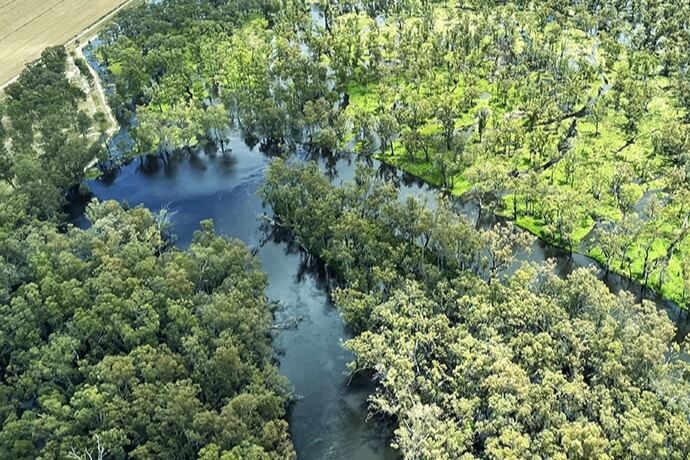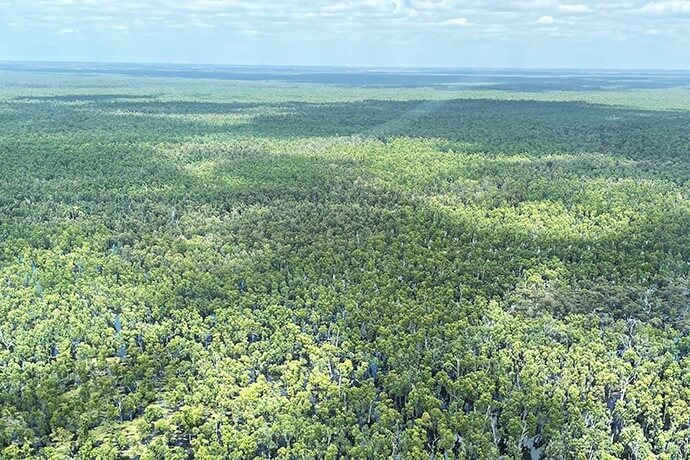On Tuesday 29 November 2022, the Murray and Lower Darling Environmental Water Advisory Group (EWAG) had an online meeting to discuss the use of water for the environment in the 2022–23 water year.
Catchment conditions
Record rains have fallen over the Murray Lower-Darling catchment from August to October 2022. Inflows at Hume Dam during this period have exceeded the previous high set in 1974–75. Recent system inflows are much higher than last year and the long-term average.
Inflows from the Barwon-Darling system continue into Menindee Lakes, with the flow at Wilcannia reaching 51,000 megalitres per day, and releases at Weir 32 on the Lower Darling-Baaka River of approximately 30,000 megalitres per day at the time of meeting.
All Basin government storages are effectively full or conducting airspace management operations.
Monitoring update
Lower Baaka native fish – movement tracking
Acoustic loggers are tracking the movement of juvenile golden perch that were tagged in Lake Menindee and released into the Lower Darling-Baaka between December 2021 and February 2022. Data from the loggers show that most movement occurred between March and May 2022, with 14 fish detected in the Talyawalka system. From the release point, numerous fish have been detected at downstream loggers, including 54 that had moved 200 km, 38 that had moved 300 km and 17 at the farthest downstream logger in the Murray River (450 km). At least 2 from the Cawndilla outlet at Tandou Creek have made their way across to the Lower Baaka River via the floodplain flow connection.
Millewa Forest – waterbird breeding monitoring
Boating restrictions for the Murray River system have meant monitoring (especially for waterbirds) has been postponed. Aerial surveillance has been used to locate colonial waterbird breeding sites across Barmah-Millewa. Large numbers of great egrets have been observed in breeding plumage in shallow floodwater around Millewa. A large colony has been detected in Barmah Forest during aerial surveys.
Koondrook-Perricoota Forest – vegetation response to flooding
The response from river red gum and black box trees to flooding has been amazing. Dissolved oxygen levels vary from very low to healthy throughout the forest. The current flooding has inundated great areas of the forest that had remained dry since the 2016–17 flood event. Engagement with the local community is required to discuss options to deliver water for the environment between wet years to maintain the current condition of the forests and to minimise the risk of hypoxic blackwater during floods.
Edward/Kolety–Wakool – water quality
Unlike most areas within the Edward/Kolety–Wakool system, the Neimur River has maintained healthy dissolved oxygen levels, supporting native fish. These observations suggest that systems, where the delivery of water for the environment has promoted a return to dominant wetland vegetation species, may be more resistant to hypoxic (low oxygen) blackwater events. Cod larvae have been detected in some locations in the Edward/Kolety-Wakool despite the low dissolved oxygen levels.
Watering event planning
Post-flood recession flows may be required to:
- mitigate hypoxic blackwater events where possible
- maintain breeding and foraging habitats at waterbird rookery sites
- maintain connectivity to allow native fish to move back to the rivers off the floodplain
The Murray and Lower Darling EWAG has a key advisory role in the decisions around the delivery of water for the environment over the next few months following the recession of this flood.

